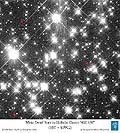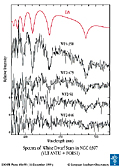Information from the European
Southern Observatory
ESO Press Release
20/99
16 December 1999
For immediate release |
|
New VLT Observations
Address the Age of the Universe
First Detailed Spectra of
White Dwarf Stars in a Globular Cluster
Recent observations with the FORS1 instrument at the first
8.2-m VLT Unit
Telescope (ANTU) by an international group of
astronomers [1]
have resulted in crucial new information about
some small and faint stars within an old star
cluster in the Milky Way.
Thanks to the enormous light gathering power
and, not least, the excellent optical quality of
ANTU , it was possible for the
first time to obtain detailed spectra of several
very faint stars in the globular cluster NGC 6397 . Earlier images with the
Hubble Space Telescope (HST) hinted that they
might be White Dwarf Stars (WDs), i.e.
Earth-size, hot and extremely dense stars that
represent the end products of the evolution of
stars like the Sun.
The VLT spectra confirmed this classification
and, even more important, have also permitted a
first determination of the stellar spectral type,
temperature and surface gravity, as well as the
mass of four WDs in NGC 6397 .
In particular, the astronomers learned that the
brightest of the four observed WDs has a mass of
about 0.35 solar masses, much lower than the mean
mass of 0.55 - 0.65 solar masses that is typical
for local white dwarfs.
Distance and age
determinations
This means that the precise distance
determination to a globular cluster, from a
comparison of its WD stars to more nearby WDs with
well-known masses and distances, will now be
possible, provided the individual properties of
the cluster WDs are well determined from such
spectroscopic observations [2].
The mass strongly influences the brightness of a
WD and comparing a low-mass globular cluster WD to
a more massive local WD would underestimate the
distance to the globular cluster. As these stars
are very faint, the spectroscopic observations
required for their analysis are very difficult and
can only be done with large telescopes like the
VLT.
Accurate distances to the globular clusters
allow to determine their age accurately. Milky Way
globular clusters like NGC 6397
are believed to be the oldest stellar aggregates
in our Galaxy. Their age therefore represents a
lower limit to the age of the universe (the time
since the Big Bang), currently estimated in the
range of 13,000 - 16,000 million years. These VLT
observations represent one crucial step towards
improving both distance and age
determinations.
Properties of White Dwarf
Stars
The new VLT observations involve White Dwarf Stars (WDs) .
Astronomers have known these strange objects for
over a century.
The first WD to be discovered was Sirius
B, a companion to Sirius, the brightest
star in the sky. It was first seen in 1862 as a
faint point of light, quite difficult to discern
next to Sirius. When the spectrum of
Sirius B was later obtained, it turned out
to be very unusual, with strong and broad
absorption lines by hydrogen. Detailed studies
have since revealed that it is a very small
stellar object, about the size of the Earth, but
still as heavy as the Sun. The density of
Sirius B is thus enormous - one million
times greater than that of the Sun, or about 1
ton/cm3!
Many other WDs have since been discovered, with
those now studied in NGC 6397 being the most
distant ever. Some of them are single, others are
members of double star systems like Sirius
B. It is now also known that they represent
the evolutionary end-product of stars with masses
up to a few solar masses (heavier stars will
explode as supernovae). A WD is in fact the
"burnt-out" stellar core that is left behind when
a star like the Sun shreds its outer layers
towards the end of its active life. This process
normally also leads to the formation of a
surrounding nebula. Many such planetary
nebulae with central WD stars are known in the
Milky Way [3].
The colours of some WDs are very blue,
indicating that they are very hot; indeed, surface
temperatures of up to 50,000 or even 100,000 °C
are common. Contrary to normal stars, the WDs
possess no inner source of energy. They are
stellar bodies that slowly cool, as they radiate
into space the remnants of energy left over from
their earlier phases.
White Dwarfs in Globular
Clusters
Globular clusters are large
aggregates of stars; over 100 are known in our
galaxy, the Milky Way. The largest contain
millions of stars. They are some of the oldest
objects observed in the universe and were
presumably formed at about the same time as the
Milky Way Galaxy, in the early phase after the Big
Bang.
With the Hubble Space Telescope (HST), a number
of very faint and blue, star-like objects were
found in some of the nearest globular clusters.
From the measured brightness and colour, they
appeared to be WDs, i.e. cluster stars that had
already reached the final stage of their
evolution.
However, detailed spectra were needed to
confirm this identification and the stars were too
faint for this type of observation to be done with
the HST.
The VLT Observations in NGC
6397
|

ESO PR Photo
45a/99
[Preview
- JPEG: 400 x 443 pix - 163k]
[Normal
- JPEG: 736 x 816 pix - 511k] |
Caption : ESO PR Photo 45a/99 shows the
very crowded sky field of the globular cluster
NGC 6397 , with some
candidate White Dwarf stars indicated by red
squares. This photo was obtained with the WPFC2
camera onboard the Hubble Space Telescope (HST).
The image sharpness is about 0.1 arcsec and the
"crosses" around the brighter stars are optical
artifacts from the telescope optics. The field
shown measures 1.3 x 1.3
arcmin2.
|
The present research programme has profited
from the excellent performance of the VLT and its
astronomical instruments to explore in unrivalled
detail some of the faint and blue objects in the
globular cluster NGC 6397 . It
is located within the constellation Ara (The
Altar), at a distance of about 8,000 light-years
and south of the galactic centre.
Following a detailed proposal to the ESO
Observing Programmes Committee, VLT observing time
for this programme was granted in early 1999 to
the team and the observations took place during
the night of September 3-4, 1999. For this, the
FORS1 multi-mode instrument at VLT ANTU that is
optimized to record the light from very faint
objects was used in the so-called
Multi-Object-Spectroscopy (MOS) mode. A
number of narrow slits at the focal plane were
adjusted so that the light from several WD
candidates in NGC 6397 passed
through and their spectra could be registered
simultaneously.
This efficient observing technique makes it
possible to obtain several spectra under equal
observational conditions. This saves much precious
telescope time and also facilitates subsequent,
direct comparison. The present observations
demanded the utmost positioning precision, to
suppress as far as possible the glare from many
other, much brighter stars in this crowded
field.
The set-up of the slits was facilitated by
accurate positional measurements on a CCD image,
previously obtained with the Hubble Space
Telescope (HST), cf. PR Photo
45a/99 . The fact that the VLT observations
took place during a period of excellent seeing,
better than 0.55 arcsec, further contributed to
the effective "isolation" of the light from the WD
candidates.
Due to the faintness of these stars - they are
of magnitude 23-24, i.e. 7 - 15 million times
fainter than can be perceived with the unaided eye
- even with ANTU/FORS1 exposure
times of 90 min were needed to register their
spectra with a sufficiently high signal-to-noise
ratio.
The VLT White Dwarf
spectra
|

ESO PR Photo
45b/99
[Preview
- JPEG: 400 x 556 pix - 160k]
[Normal
- JPEG: 800 x 1111 pix- 440k] |
Caption : ESO PR Photo 45b/99 displays the
spectra of four White Dwarf stars in globular
cluster NGC 6397, obtained with ANTU/FORS1 and
identified as such from these data. The spectra
were shifted vertically so that they do not
overlap. The wavelength is indicated along the
abscissa; the intensity along the ordinate. A
"standard" spectrum of a White Dwarf star (of
spectral type DA - the hydrogen-rich variety) is
shown at the top for comparison. Broad
absorption lines from hydrogen atoms in the
atmosphere are visible. Although the
signal-to-noise ratio is quite small, especially
for the lower spectra of the fainter stars, they
all show the same strong, broad absorption lines
as the comparison spectrum. This permits to
classify them unambiguously as WD stars.
Individual differences, for instance of the
widths of the absorption lines, are clearly
present and point to different surface gravity
and masses. |
The spectra of four candidate WDs, recorded by
FORS1 during these observations, are shown in PR Photo 45b/99 . They are
characterized by the presence of several wide
absorption lines of hydrogen, all typical in WD
spectra and thus clearly identifying these objects
as such.
Although they may look quite similar to the
eye, a preliminary analysis reveals important
individual differences. In particular, the shapes
of hydrogen lines may be used to estimate the
temperature and (surface) gravity in the shallow
atmospheres; the best value for the temperature
derived from the spectrum of the brightest star
(WF4-358; the uppermost spectrum) is about
18,000 °C.
The masses of the WD stars can be deduced from
the temperatures and surface gravities.
Interestingly, the four stars are found to have
different masses, with about 0.36 solar masses for
WF4-358 and about 0.50 solar masses for the
others. The presence of such a spread in mass may
bias the distance determination if one assumed
that all the WDs in a globular cluster have the
same mass.
Continuation of this
work
The next step will be to obtain better spectra
of the White Dwarfs in NGC 6397, that will
allow to derive the stellar parameters more
accurately. It is also planned to extend this
project to two more globular clusters, in which
white dwarf candidates have been found with
HST.
The team has described the new results in a
scientific article, submitted to the European
research journal Astronomy &
Astrophysics.
Notes
[1] The team consists of
Sabine Moehler (Principal Investigator),
Ulrich Heber and Ralf Napiwotzki
(all at Dr. Remeis Sternwarte, Astronomisches
Institut der Universität Erlangen-Nürnberg,
Bamberg, Germany), Detlev Koester (Institut
für Theoretische Physik and Astrophysik, Kiel,
Germany) and Alvio Renzini (European
Southern Observatory, Garching, Germany).
[2] This method to determine
astronomical distances is based on the fact that
the brightness of an object is inversely
proportionate to the square of the distance. If
two stars are identical in all respects, and if
the distance to one of them is known, the distance
to the other one can therefore be accurately
determined from the measured (apparent) brightness
difference. However, if they are not absolutely
identical, e.g. if their masses and thus their
intrinsic brightness differ, a suitable correction
will have to be applied.
[3] One spectacular example
of a planetary nebula with a central White Dwarf
star is the Dumbbell Nebula, observed last year
with the VLT, cf. ESO
PR Photos 38a-b/98 .
How to obtain ESO Press Information
ESO Press Information is made available on the
World-Wide Web (URL:http://www.eso.org/outreach/press-rel/
). ESO Press Photos may be reproduced, if credit
is given to the European Southern Observatory.
| 
